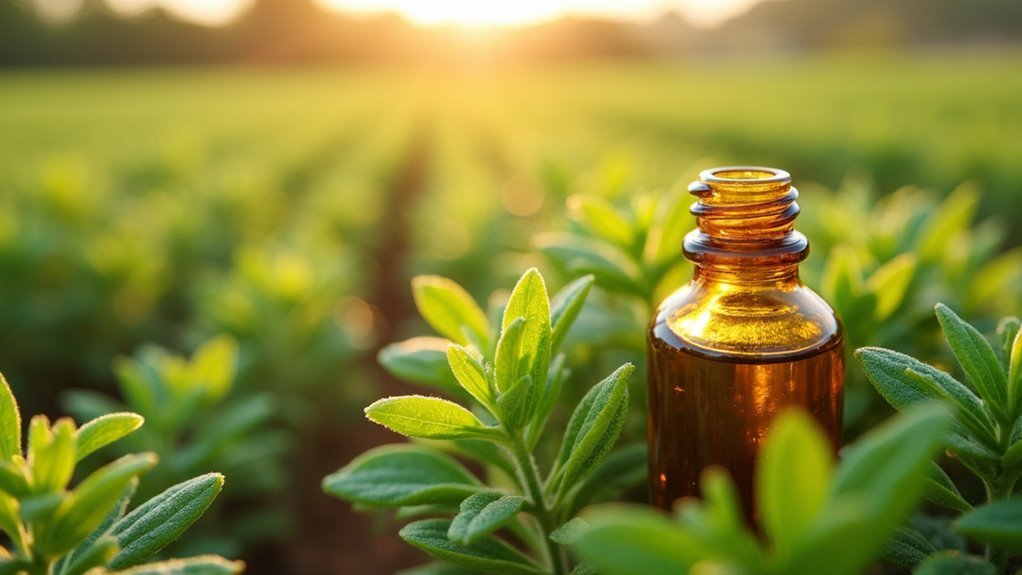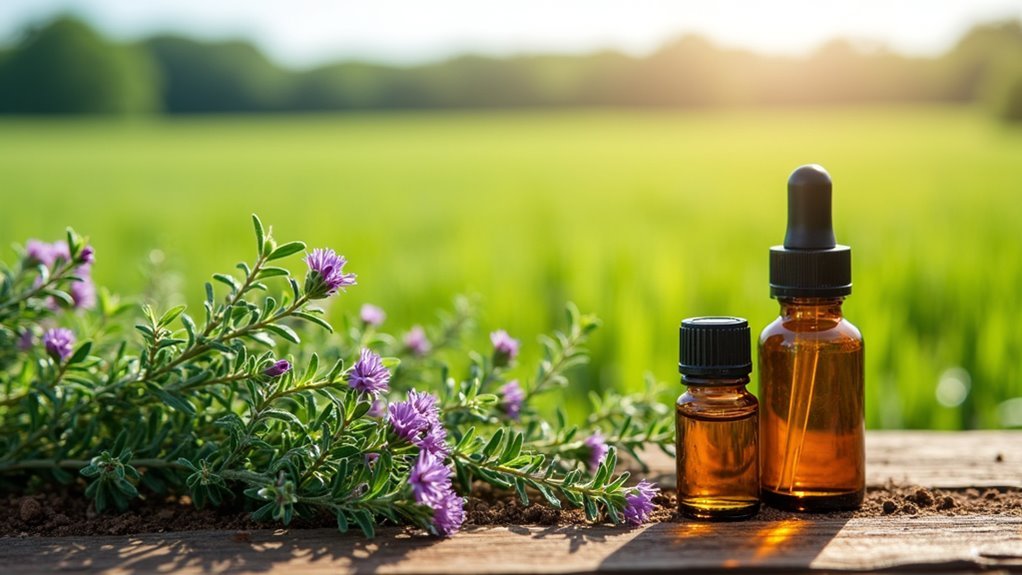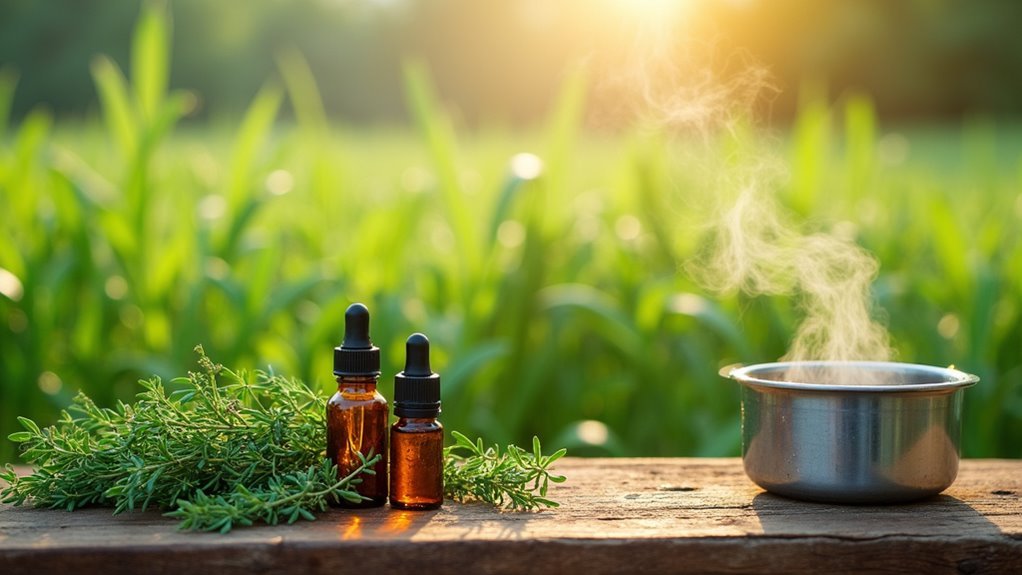You’ll harness thyme oil’s powerful antimicrobial compounds by using proper dilution ratios—0.5% for established crops and 0.25% for newly planted ones. Apply through soil drenching, in-furrow spraying, or foliar applications to target pests at different stages. Combine with neem or peppermint oils for enhanced effectiveness, and store in dark, cool places to maintain potency for 2-3 years. Time applications during peak pest activity periods for maximum disruption. These strategic approaches will transform your farm’s integrated pest management success.
Understanding Thyme Oil’s Active Compounds and Their Pesticidal Properties

When you examine thyme oil’s composition, you’ll discover that thymol serves as its powerhouse component, making up 37-55% of the oil and delivering potent antimicrobial action by disrupting cellular membranes in harmful pathogens.
Thymol dominates thyme oil at 37-55% concentration, destroying pathogen cell membranes with powerful antimicrobial force.
You’ll find that thyme oil’s active ingredients work synergistically to enhance its pesticidal properties. Carvacrol and linalool boost the oil’s antioxidant capabilities while expanding its antimicrobial spectrum against various plant diseases and insect pests.
Additionally, p-Cymene and γ-terpinene contribute 10.50% to 16% of the composition, further strengthening the oil’s unique antimicrobial characteristics.
This powerful combination makes thyme oil an exceptional pest control solution, demonstrated by its impressive 100.93% inhibition rate against Huanglongbing disease in citrus crops.
Proper Dilution Ratios for Different Crop Types and Growth Stages
Although thyme oil’s active compounds provide impressive pesticidal properties, you’ll achieve ideal results only when you apply the correct dilution ratios tailored to your specific crop types and their current growth stages.
Established crops require a 0.5% dilution—mixing 2 quarts of thyme oil with 100 gallons of water for effective pest control. Newly planted crops need gentler treatment with a 0.25% dilution using 1 quart per 100 gallons to prevent phytotoxicity.
Key Application Methods:
- Soil drench treatments – Use ½ gallon thyme oil’s concentration per 100 gallons for thorough root zone saturation
- In-furrow seed applications – Apply 14 fl oz per acre directly into furrows before covering seeds
- Chemigation systems – Adjust dilution ratios based on your irrigation method and crop growth stage
Soil Application Methods for Maximum Root Zone Protection

Three primary soil application methods deliver thyme oil’s protective compounds directly to your crops’ root zones, where they’ll intercept soil-dwelling pests before they can damage plant foundations.
Soil drenching provides extensive coverage by mixing ½ gallon of thyme oil in 100 gallons of water, thoroughly saturating the entire root zone. This method targets soil-borne pathogens and pest populations effectively.
In-furrow spray application delivers 14 fl oz per acre directly into seed furrows before covering, protecting vulnerable seedlings during establishment.
Chemigation utilizes your existing irrigation systems to distribute thyme oil efficiently throughout the root zone. This method guarantees ideal absorption while reducing harmful pest populations by 100.93% against major pathogens.
These soil application techniques form essential components of integrated pest management strategies.
Foliar Spray Techniques for Targeting Airborne Pests and Diseases
Foliar applications of thyme oil create a protective barrier across leaf surfaces, stems, and other exposed plant parts where airborne pests and diseases typically establish their first foothold.
This natural approach targets pathogens like powdery mildew while deterring flying insects before they can damage your crops.
For effective foliar spray application, dilute thyme oil at 0.5% for established crops and 0.25% for newly planted ones.
Allow the solution to dry completely before removing dead pests to maximize contact time and efficacy.
- Enhance effectiveness by combining thyme oil with other essential oils like neem or cinnamon for broader pest spectrum control
- Monitor regularly during high pest pressure periods and reapply as needed for consistent disease management
- Time applications wisely during cooler hours to prevent leaf burn and improve absorption
Combining Thyme Oil With Other Essential Oils for Enhanced Effectiveness

You’ll amplify thyme oil’s pest control power by strategically combining it with complementary essential oils that target different aspects of pest behavior and plant protection.
When you blend thyme oil with oils like neem, cinnamon, clove, or peppermint, you’re creating synergistic combinations that attack pests through multiple pathways while providing broader antimicrobial coverage.
You’ll need to adjust your application rates carefully since these enhanced blends often require lower concentrations to achieve superior results compared to single-oil treatments.
Synergistic Oil Combinations
While thyme oil’s individual pest control properties are impressive, combining it with other essential oils creates synergistic effects that greatly amplify its effectiveness.
These strategic combinations enhance antimicrobial activity and broaden pest control spectrum while reducing resistance development risks.
You’ll achieve exemplary results through integrated pest management by pairing thyme oil with complementary essential oils. Each combination targets specific pest challenges while supporting sustainable pest management practices.
Top Synergistic Thyme Oil Combinations:
- Thyme + Neem Oil – Targets broader pest range while minimizing resistance development
- Thyme + Cinnamon Oil – Increases antimicrobial activity against fungal pathogens and insect pests
- Thyme + Clove Oil – Bolsters pesticidal properties, especially effective against aphids and whiteflies
These synergistic effects maximize your pest control outcomes while maintaining environmental sustainability.
Application Rate Adjustments
Proper application rates become even more important when combining thyme oil with other essential oils, as each blend requires specific dilution adjustments to maximize synergistic benefits without overwhelming your plants.
You’ll want to maintain thyme essential oil at 0.5% dilution for established crops and 0.25% for newly planted ones when creating combination treatments.
These application rate adjustments guarantee minimum risk to your crops while delivering effective natural pest control against multiple insect species simultaneously.
When blending thyme with neem or cinnamon oils, you’re creating tailored solutions that target broader pest ranges through synergistic antimicrobial properties.
Regular applications using proper dilution rates help prevent pest resistance while maintaining low environmental impact, making these combinations ideal for sustainable integrated pest management strategies.
Timing Applications for Optimal Pest Life Cycle Disruption
Timing thyme oil applications strategically disrupts pest life cycles by targeting their most vulnerable stages—larvae and young adults that haven’t yet developed full resistance to treatments.
Apply during early morning or late afternoon when cooler temperatures enhance absorption and minimize evaporation. Regular monitoring of pest populations helps you time applications precisely before they reach damaging levels, ensuring proactive management rather than reactive responses.
- Monitor threshold levels – Apply thyme oil when pest counts exceed established economic injury levels to maximize control effectiveness
- Target reproductive cycles – Strategic timing applications can break breeding patterns of aphids and whiteflies, reducing future generations
- Schedule during vulnerable stages – Focus treatments when pest life cycles are at their most susceptible developmental phases for maximum impact
Storage and Handling Best Practices to Maintain Oil Potency
Effective pest control depends not only on precise application timing but also on using thyme oil that maintains its full potency throughout storage.
You’ll need to store your thyme oil in cool, dark places between 5-30°C to prevent degradation. Use amber bottles specifically, as they shield the oil from light damage that compromises effectiveness.
Keep bottle lids tightly closed to prevent oxidation, which diminishes quality over time.
Label each bottle with its opening date to track shelf life—properly stored thyme oil retains potency for 2-3 years.
You should regularly inspect your stored oil for changes in color, aroma, or viscosity, as these indicate lost potency or spoilage.
Following these storage practices guarantees your pest control applications remain effective throughout the growing season.
Frequently Asked Questions
What Bugs Does Thyme Oil Repel?
You’ll find thyme oil effectively repels aphids, whiteflies, and mites. It’s particularly potent against sucking insects due to thymol disrupting their cellular membranes, causing paralysis and death without harming beneficial insects.
What Do Farmers Use for Pest Control?
You’ll find farmers using synthetic pesticides, biological controls, crop rotation, beneficial insects, herbicides, and fungicides for pest management. They’re increasingly adopting integrated pest management strategies that combine chemical, biological, and cultural control methods effectively.
Is Thyme Good for Pest Control?
Yes, you’ll find thyme’s extremely effective for pest control. It’s got strong antimicrobial properties that kill aphids, whiteflies, and mites while acting as a natural fungicide and bactericide without causing resistance.
How to Use Essential Oils for Pest Control?
You’ll dilute essential oils like thyme at 0.5% for established crops or 0.25% for new plantings. Apply through soil drenching, spraying, or chemigation. Combine different oils for broader pest coverage and enhanced effectiveness.
In Summary
You’ve now got seven proven strategies to transform thyme oil into your farm’s natural pest control powerhouse. Start with proper dilution ratios, master your application timing, and don’t forget to store your oil correctly to maintain its potency. By combining these techniques with complementary essential oils, you’ll create a thorough pest management system that’s both effective and environmentally responsible. Your crops will thrive while harmful pests become a thing of the past.





Leave a Reply